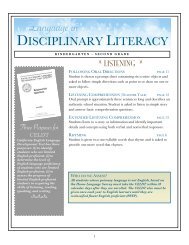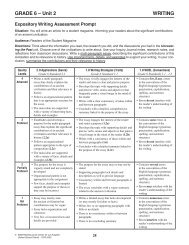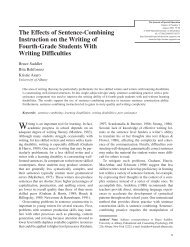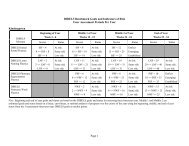Beyond Phonics: Integrated Decoding and Spelling Instruction ...
Beyond Phonics: Integrated Decoding and Spelling Instruction ...
Beyond Phonics: Integrated Decoding and Spelling Instruction ...
You also want an ePaper? Increase the reach of your titles
YUMPU automatically turns print PDFs into web optimized ePapers that Google loves.
DECODING AND SPELLING— WORD ORIGIN AND STRUCTURE 269categories of word structure, or strategies, available for analyzing unfamiliarwords, i.e., letter-sound correspondences, syllable patterns, <strong>and</strong>morpheme patterns; <strong>and</strong> on the three layers of language forming the basisfor the majority of words in English, i.e., Anglo-Saxon, Romance, <strong>and</strong>Greek. Students learn specific decoding <strong>and</strong> spelling strategies based onthis model. The notion of word origin from an historical perspective flowsthrough each unit. The design <strong>and</strong> sequence of the instructional unitsremain the same for all students, although words selected for practice differdepending on grade level. For example, first graders may only be introducedto Anglo-Saxon letter-sound correspondences. Upper grade elementarystudents may organize letter-sound information, but may focuson syllable <strong>and</strong> morpheme patterns in multi-syllabic words.The goal is to make students keenly aware that words of differentorigins may have different patterns. For example, words of Greek originadd three new letter-sound correspondences, /ch/ as in chorus, /ph/ as inphonograph, <strong>and</strong> /y/ as in symphonic.Topics for instruction are organized as follow:Unit ILetter-Sound CorrespondencesUnit II Syllable PatternsUnit III Layers of LanguageUnit IV Morpheme PatternsUnit V Practicing Strategies for Long, Unfamiliar WordsI. Letter-sound correspondences. As these patterns are introduced, thecorrespondences are organized into a logical set of six categories found inthe 2 Õ 3 matrix described earlier. This matrix represents the way lettersoundcorrespondences can be organized for instruction. In addition tolearning the patterns in each category, students explicitly learn the terminologyspecific to word features.Teachers usually place a chart of this matrix in the classroom. As theteacher presents new patterns, she writes the pattern in the appropriatecell in the matrix. Students learn that words have both consonants <strong>and</strong>vowels, the two major headings. Consonants are either single letters,blends, or digraphs. Single-letter vowels can have either short or long"sounds," often lose their traditional sound when followed by -r or -l, <strong>and</strong>are called vowel digraphs when combined with other vowels. Almost allgraphemes, the letter patterns appearing in words, can be placed in oneof these six cells. This makes it possible to organize within a coherentframe the almost 200 different letter-sound patterns.II. Syllable Patterns. Students begin by discussing the meaning of theterm "syllable" <strong>and</strong> practice counting the number of syllables in a groupof 2-5 syllable words. During this unit they discuss both simple <strong>and</strong> complexsyllable division patterns, depending on grade level. These patternsexist in most multisyllabic words. Students read long words <strong>and</strong> divide






